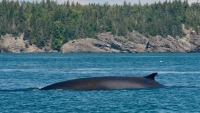
(Photo: Danielle Dion)
Baleine à fanons ou rorqual commun
Balaenoptera physalus
Le rorqual commun est la deuxième plus grande espèce de baleine. Il peut atteindre 26 mètres de long et peser jusqu’à 80 tonnes. Il a un corps allongé avec une tête en forme de V. Il a une grande nageoire dorsale distincte en forme de crochet, située à environ deux tiers de la longueur du corps. Une crête distincte se trouve entre la nageoire dorsale et la queue. On le nomme parfois ‘razorback’ (dos en lame de rasoir). Le dos et les côtés du rorqual commun sont noirs ou gris-brun et son ventre est blanc. Sur la tête, il a des marques grises ou blanches en forme de chevrons. La couleur distincte de sa mâchoire inférieure est foncée du côté gauche et pâle du côté droit.
L’autorité
Linnaeus, 1758
La classification des détails
Embranchement : Chordata (cordés); Sous-embranchement : Vertebrata (vertébrés); classe : Mammalia (mammifères); Ordre : Cetacea (baleines et dauphins); Sous-ordre : Mysticeti (baleines à fanons).
L’habitat
Les rorquals communs se trouvent dans tous les grands océans. Trois sous-espèces de rorquals communs se trouvent dans différents lieux. Les rorquals communs sont souvent en groupes de deux à sept individus. L’été, les rorquals communs se nourrissent dans les eaux froides du nord ou du sud. Durant les mois d’été dans l’est du Canada, ils se trouvent dans le golfe du Saint-Laurent, sur le plateau néo-écossais, dans la baie de Fundy et au large de Terre-Neuve et du Labrador. L’hiver, ils migrent vers des zones d’eaux tropicales pour s’accoupler et donner naissance, mais tous les rorquals n’y vont pas chaque année.
L’alimentation
Se nourrissent en filtrant l’eau. Ils nagent à travers des bancs de proies en prenant d’énormes volumes d’eau dans leur gueule. Ils filtrent ainsi l’eau à travers leurs fanons, piégeant les proies sur les franges des cheveux des fanons. Ils ont entre 260 et 480 fanons. Ils lèchent les proies des fanons avec leur langue et les avalent. Leur nourriture inclut le krill, les petits poissons (hareng, capelan, lançon) et les calmars. Un rorqual commun peut manger jusqu’à deux tonnes de nourriture par jour.
La reproduction
Ils ont des sexes distincts. On connait peu du comportement de la reproduction de cette espèce. Les mâles atteignent la maturité sexuelle entre l’âge de 6 et 10 ans et les femelles, entre 7 et 12 ans. Les femelles donnent naissance à un baleineau à la fin de la période de gestation de 11 à 12 mois. Les femelles voyagent sous les tropiques pour donner naissance. Les baleineaux sont environ six mètres de long à la naissance et leur mère les allaite pendant six mois. Les rorquals communs peuvent vivre plus de 100 ans.
Des faits amusants
Cette espèce est en voie de disparition partout à travers son habitat. Les pêches commerciales des baleines les ont éliminées en grand nombre entre le milieu des 1900 et 1980. Avant la période de pêche commerciale, les populations dans l’Atlantique Nord dénombraient environ 30 000 à 50 000 individus. Aujourd’hui, on en compte environ 3 000. Les rorquals communs meurent surtout à cause des emmêlements dans les cordes d’équipements de pêche et des collisions avec les navires. De plus, il existe encore quelques pays qui continuent à chasser cette espèce en péril.
Les scientifiques ont découvert que les rorquals communs s’accouplaient parfois avec les rorquals bleus, produisant des hybrides. Certains de ces hybrides sont féconds (une caractéristique rare chez les animaux hybrides).
Les rorquals communs sont reconnus comme les lévriers des mers ; ils peuvent nager à des vitesses de plus de 45 kilomètres à l’heure pour de courtes durées.
Références
COSEWIC (2005) COSEWIC assessment and update status report on the fin whale Balaenoptera physalus in Canada. Committee on the Status of Endangered Wildlife in Canada. Ottawa. ix + 37 pp. (www.sararegistry.gc.ca/status/status_e.cfm). Eder T (2012) Whales and Other Marine Mammals of Atlantic Canada. Vancouver: Lone Pine Publishing. NOAA (2021) Fin Whale. Species Directory. https://www.fisheries.noaa.gov/species/fin-whale#overview Consulté en ligne le 11 mai 2021. Pampoulie C, Gíslason D, Ólafsdóttir G, Chosson V, Halldórsson SD, Mariani S, Elvarsson B, Rasmussen MH, Iversen MR, Daníelsdóttir AK and Víkingsson GA (2020) Evidence of unidirectional hybridization and second generation adult hybrid between the two largest animals on Earth, the fin and blue whales. Evolutionary Applications 00, 1– 8. https://doi.org/10.1111/eva.13091. Perrin WF (2020). World Cetacea Database. Balaenoptera physalus (Linnaeus, 1758). Accessible via : World Register of Marine Species at: http://www.marinespecies.org/aphia.php?p=taxdetails&id=159023 Consulté en ligne le 20 janvier 2020.

